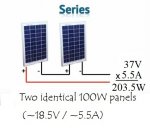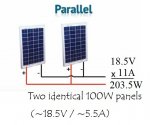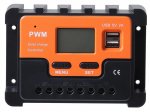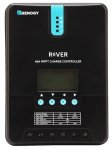- 1,725
- 1,826
- 113
- Location
- Nova Laboratories, WA
Intro
I'm going to cover some fundamentals of solar power including types of panels, safety equipment, and best practices when implementing a solar system. Electrical is an entirely different subject that I'll go into at a later date, and will discuss integration into an existing system, but you really need to match your electrical demands to your solar system, and vice-versa. I will go into more detail on general electrical in another thread, as this is focused on the solar aspect.
Solar panels are also known as Photovoltaic, or PV for short. If you see 'PV', I'm talking about a solar panel
Some of the topics discussed will be...
- Basics of solar panels
- Solar power generation
- Types of panels
- Charge controllers
- Wiring
The information provided is based on years of experience and training, and is designed to be a general overview. Please seek a qualified electrician or mobile installer if you need to. I'm not responsible if you burn your truck down or fall off your roof..
----------------------------------------------------------------------------------------------------------------------------------------------------------------------------------
Fundamentals
Solar panels use the sun to generate electricity. Yeah. I know that's kind of a no-brainer, but we're starting off with the basics. Here's a general list of things to keep in mind...
- Solar panels don't like heat. I know, it's counterintuitive, but panels can overheat, and will produce less power in extreme temps (120*+)
- Solar panels will work even on cloudy days, although generally only outputting 10-20% of their rated power.
- Larger solar panel installations can produce dangerous voltages and high currents. If you're not sure what you're doing, consult a professional.
- The average 100W consumer panel produces ~18V @ ~5.5A.
- Solar panels work best when angled properly, HOWEVER, in mobile installations, it's probably gonna be laid flat. Just understand you will lose a little output in doing so.
Energy Production
Solar panels aren't always the best answer in every situation. The use of solar really depends on your environment. Areas with lots of overcast days are not going to be great for producing a lot of power. Every area has calculated 'sun hours'.. Hours of full output from the solar panel, based on location, and time of year. Your panels will still produce output both before, and after, peak hours, but at lower rates.
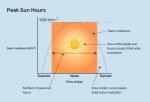
Here is a general map of solar output based on location.
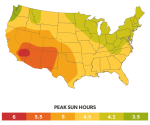
The above map shows an average of Peak Sun Hours, or Peak Solar Hours, for your PV system. Because this changes during the season, you will get less hours during the winter, and more hours in the summer.
Generally speaking, solar output is measured in watt hours or kilowatt hours. The amount of electricity generated can be guesstimated fairly easily, using the charts above. Again, this is averages, so individual days could be significantly lower, or higher.
A tale of two cities...
So, let's say you have 4 - 100w panels, for a total of 400W... Assuming full production for ONE hour, would be 400 watt hours, or 400 Wh..
Let's look at two cities, using solar peak hour averages, to figure out how much power we'd be making... This is assuming the panel is laying flat, and not angled.
Using Albuquerque as an example.
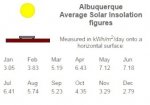
- Summer Peak Sun Hours (June): 7.18 hours per day (400 * 7.18 = 2,872 Wh, or 2.872 KWh)
- Winter Peak Sun Hours (Dec): 2.79 hours per day (400 * 2.79 = 1,116 Wh, or 1.116 KWh)
Some areas aren't so lucky....
Using Seattle as an example..
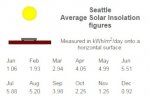
- Summer Peak Sun Hours (July): 5.88 hours per day (400 * 5.88 = 2,352 Wh, or 2.352 KWh)
- Winter Peak Sun Hours (Dec): .92 hours per day (400 * .92 = 368 Wh )
To put that in perspective... Let's say you have 3, 12V LED lamps, that consume 1/2 an amp, or 500mah, for a total of 1.5A...
V*A=W
12 * 1.5 = 18W...
So, NOT including losses in line, charge controller efficiency, battery efficiency, etc. and assuming that everything else is 100% efficient (which it most surely is not, and never will be)... In Albuquerque, in the winter, on ONE day of collection, you'd bring in enough juice to run the lights for 62 hours. In Seattle, you'd bring in enough juice to power those same lights for a little over 20 hours...
The ideal setup would be to have enough solar to provide for your needs during the day AND fully charge your battery bank from the usage of the night before. Sizing your battery bank is another topic I'll be discussing in another thread. Your solar setup will depend on your needs and battery capacity.
-----------------------------------------------------------------------------------------------------------------------------------------------------
Panel Types
Solar panels come in 3 main varieties, Polycrystalline, Monocrystalline and amorphous (thin film). Because we're focusing on vehicle applications, I'm leaving out amorphous, as it's not rugged, and is very space inefficient compared to poly or mono panels, and is considerably more expensive.
Polycrystalline panels tend to have a less uniform, bluish tint, and are easily distinguishable from Monocrystalline. Poly panels require a larger surface area in order to produce the same amount of power, but can be a little better at producing power in adverse conditions,
PROS:
- Less expensive
CONS:
- Less efficient
- Not a uniform appearance
Monocrystalline
Mono panels are made from larger wafers of silicon, and have a uniform black appearance to their cells. They are also more efficient, and can produce more power from a smaller sized panel than an equivalent sized poly panel...
PROS:
- More efficient
- Smaller size
- Uniform appearance
Cons:
- More expensive
Charge controllers and wiring coming up next....
Last edited:



